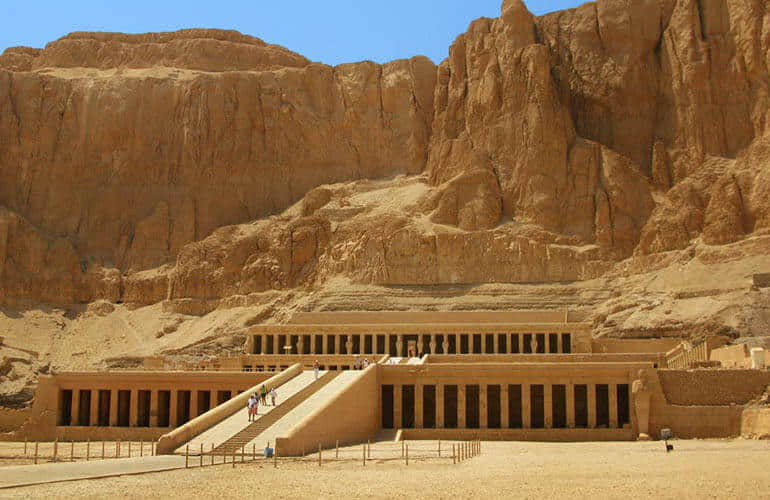
10 Powerful Valley of the Kings Egypt Facts You Must Know
Valley of the Kings Egypt Facts ,Valley of the Kings in Egypt is one of the most renowned archaeological treasures in the world. This ancient burial ground, situated near Luxor, is home to the tombs of pharaohs and noble elites from the New Kingdom (1550-1070 BC). Steeped in history and surrounded by mysteries, it offers a fascinating glimpse into ancient Egyptian life, death, and beliefs. In this blog, we’ll explore key Valley of the Kings Egypt facts to help you better understand this magnificent site.
Why the Valley of the Kings Was Chosen
One of the most significant Valley of the Kings Egypt facts is its unique location. The valley was carefully chosen for its proximity to Thebes (modern-day Luxor) and the isolated desert setting, which offered protection against tomb robbers. The natural pyramid-shaped peak of Al-Qurn, standing above the valley, symbolized eternal life—a fitting tribute to the pharaohs and their journey to the afterlife.
Valley of the Kings Egypt Facts: The Number of Tombs

The valley is home to over 60 tombs, each varying in size and complexity. Some are small pits, while others stretch into elaborate underground complexes with multiple chambers. These tombs belonged to pharaohs, nobles, and royal family members, each aiming to ensure a safe passage to the afterlife. As of today, 65 tombs have been identified, with more discoveries still possible.
King Tutankhamun’s Tomb: The Most Famous Discovery
No list of Valley of the Kings Egypt facts would be complete without mentioning the discovery of King Tutankhamun’s tomb. In 1922, British archaeologist Howard Carter uncovered this nearly intact tomb, filled with treasures, including the famous golden mask. This discovery provided an unparalleled look into ancient Egyptian burial practices and became one of the greatest archaeological finds of the 20th century.
Valley of the Kings Egypt Facts: The Curse of the Pharaohs
One of the more curious Valley of the Kings Egypt facts is the belief in the “Curse of the Pharaohs.” This idea gained popularity after the discovery of Tutankhamun’s tomb when several people involved in the excavation died under mysterious circumstances. Though many dismiss this as coincidence, the curse has become a part of the valley’s allure, adding a layer of intrigue to its already rich history.
The Architecture of the Tombs
When examining Valley of the Kings Egypt facts, the tomb architecture stands out for its complexity and beauty. Tombs were designed to protect the pharaohs in the afterlife, with intricate layouts that featured long passageways, false doors, and hidden chambers. The walls of the tombs are adorned with vivid paintings and inscriptions from the Book of the Dead, offering guidance for the soul’s journey through the underworld.
Valley of the Kings Egypt Facts: Modern Preservation Efforts
Today, the Valley of the Kings faces the challenge of preserving these ancient tombs for future generations. Many of the tombs, particularly those with delicate wall paintings, are vulnerable to environmental damage and wear from tourism. One of the key Valley of the Kings Egypt facts is that some tombs have been closed to the public or have limited access to protect these precious artifacts.
In recent years, replicas of some tombs, such as King Tutankhamun’s, have been created to allow visitors to experience the valley’s grandeur without risking damage to the originals.
The Importance of the Valley of the Kings in Ancient Egyptian Beliefs
One of the core Valley of the Kings Egypt facts is its role in ancient Egyptian religious beliefs. Egyptians believed that death was not the end but a transition to another realm. The tombs in the valley were designed not just as burial chambers but as eternal homes where the dead could live on, surrounded by items they would need in the afterlife. These tombs were often filled with food, furniture, jewelry, and other luxuries.
Fascinating Discoveries Beyond King Tutankhamun’s Tomb
While King Tutankhamun’s tomb is the most famous, other remarkable tombs in the valley are worth noting. For example, the tomb of Ramses VI is one of the largest and most elaborately decorated, with walls covered in stunning hieroglyphs and vivid scenes from the underworld.
Another notable discovery is the tomb of Amenhotep II, which contained not only his mummy but also several other royal mummies. This find provided key insights into the burial practices of the 18th dynasty.
Valley of the Kings Egypt Facts: Recent Excavations
Despite the valley being extensively explored over the last two centuries, it still holds secrets. One of the more recent Valley of the Kings Egypt facts is the discovery of KV63 in 2005, a tomb that did not contain a body but was filled with burial equipment and embalming materials. This discovery highlights the ongoing potential for new findings in the valley, even today.
The Valley of the Kings as a Tourist Attraction
Visiting the Valley of the Kings is one of the highlights of any trip to Egypt. Tourists can enter several of the tombs, including those of Ramses IV, Ramses IX, and the ever-popular King Tutankhamun (though this comes at an additional fee). While exploring the valley, visitors can witness firsthand the artistry and architectural genius of the ancient Egyptians.
Final Thoughts on Valley of the Kings Egypt Facts
The Valley of the Kings Egypt facts demonstrate just how significant this site is, not just for Egypt but for world history. Its tombs hold stories of ancient kings, remarkable craftsmanship, and religious beliefs that shaped one of the greatest civilizations ever known. Whether you’re fascinated by ancient history, intrigued by the mystery of the pharaohs, or simply curious about the lives of the people buried there, the Valley of the Kings offers something for everyone.
A visit to the Valley of the Kings is an unforgettable journey into the past, and with ongoing excavations and discoveries, it continues to reveal new chapters of Egypt’s rich and vibrant history.
Related:
Recent Posts
Edfu Temple :5 Reasons to Explore the Majestic Today
Discover 7 Amazing Features of Sinbad Hotel Egypt for 2024
Top 7 Reasons to choose Egypt Air Hospital in Egypt
All Categories
Tags

Thailand





